Reconnecting a SQL Server dSource Following a Mirroring Failover (KBA1390)
KBA
KBA#1390Applicable Delphix Versions
- Click here to view the versions of the Delphix engine to which this article applies
-
Major Release All Sub Releases 6.0 6.0.0.0, 6.0.1.0, 6.0.1.1, 6.0.2.0, 6.0.2.1, 6.0.3.0, 6.0.3.1, 6.0.4.0, 6.0.4.1, 6.0.4.2, 6.0.5.0, 6.0.6.0, 6.0.6.1, 6.0.7.0, 6.0.8.0, 6.0.8.1, 6.0.9.0, 6.0.10.0, 6.0.10.1, 6.0.11.0 5.3
5.3.0.0, 5.3.0.1, 5.3.0.2, 5.3.0.3, 5.3.1.0, 5.3.1.1, 5.3.1.2, 5.3.2.0, 5.3.3.0, 5.3.3.1, 5.3.4.0, 5.3.5.0 5.3.6.0, 5.3.7.0, 5.3.7.1, 5.3.8.0, 5.3.8.1, 5.3.9.0 5.2
5.2.2.0, 5.2.2.1, 5.2.3.0, 5.2.4.0, 5.2.5.0, 5.2.5.1, 5.2.6.0, 5.2.6.1
5.1
5.1.0.0, 5.1.1.0, 5.1.2.0, 5.1.3.0, 5.1.4.0, 5.1.5.0, 5.1.5.1, 5.1.6.0, 5.1.7.0, 5.1.8.0, 5.1.8.1, 5.1.9.0, 5.1.10.0
5.0
5.0.1.0, 5.0.1.1, 5.0.2.0, 5.0.2.1, 5.0.2.2, 5.0.2.3, 5.0.3.0, 5.0.3.1, 5.0.4.0, 5.0.4.1 ,5.0.5.0, 5.0.5.1, 5.0.5.2, 5.0.5.3, 5.0.5.4
Troubleshooting Reattaching a dSource to a SQL Server Source Database
This article provides information on how to reattach a dSource to a SQL Server Source Database following the failover of a SQL Server Mirrored Database.
If a SQL Server database in a Database Mirroring configuration is failed over to the mirror server, the Delphix Engine will report that it is no longer able to contact the Source database, with the message "dSource - Cannot contact source":
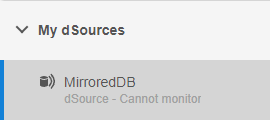
This is because the source database linked and connected to the Delphix Engine, as the dSource, is no longer the active database, but the standby (mirrored) database. The mirrored database is in NORECOVERY mode and can no longer be queried by the Delphix Engine.
Using the steps provided in this document, a dSource can be reconnected to the new active database.
Resolution
To reconnect to the Source Database following a failover, the dSource must be unlinked from the existing Source Instance, and then reattached to the SQL Server instance which now hosts the Primary copy of the database.
This involves the following steps:
- Adding the new environment to the Delphix Engine
- Recording the current dSource Configuration
- Detaching the dSource
- Attach the dSource to the new environment
- Additional steps for forced mirroring failovers
Adding the new environment to the Delphix Engine
The host will need to be added as an Environment to the Delphix Engine, if this has not already been done. This can be performed from the Manage -> Environments screen, using the Add Environment button.
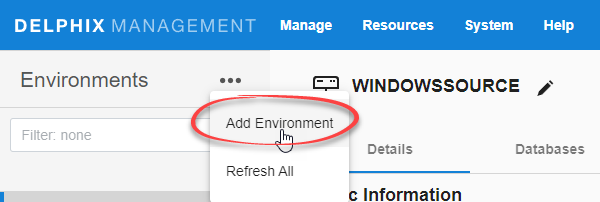
The new environment will need to meet the same requirements as any other Windows Source Environment, as described in Overview of Requirements for SQL Server Environments.
Recording the current dSource Configuration
From the Manage -> My Datasets screen, browse to the Configuration tab of the dSource, and note the value of all editable fields, including:
- Database User (DB User)
- Validated Sync Mode
- Staging Environment
- Autodiscover Backup Path setting, and/or the configured Backup Path
In most cases, you will want to replicate these settings when reattaching the dSource.
Most of these settings can be found in the Source and Data Management tabs.
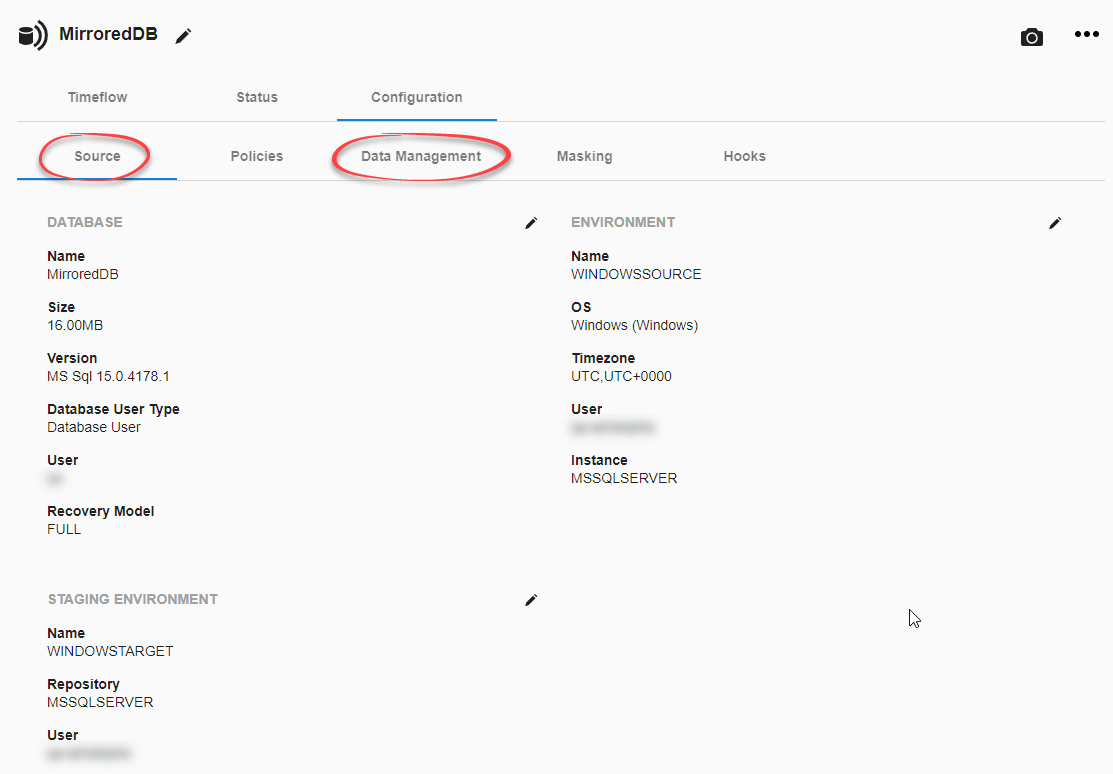
If you are using a Database User Type of "Database User", please note that the user password cannot be extracted from the Delphix Engine. You will need to retrieve this password from your own records for entry in a later step.
Detaching the dSource
The dSource can be detached using Unlink dSource button of the dSource, accessible from the ellipsis (...) menu.

Once this is complete, the dSource will appear in the left-hand dataset lists as Detached.
Attaching the dSource to the new environment
The dSource can then be reattached to the new environment using the Link dSource button, accessible from the ellipsis (...) menu.

This will allow you to reattach the Delphix Engine to the current Primary mirroring node.
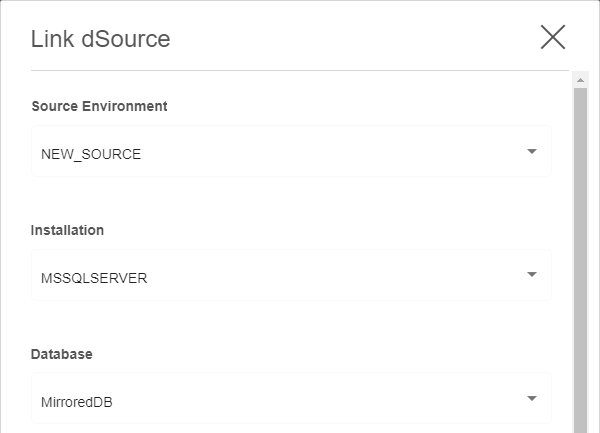
For more information on this process, please see the document Detaching and Reattaching SQL Server dSources.
This will trigger an "Attach source" action:
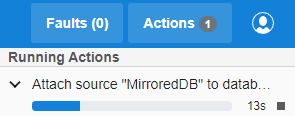
Once this action is complete, you should check each setting in the Configuration tab of the dSource, changing settings to match those that you noted earlier or adjusting them as required to suit your new Source Environment.
Additional steps for forced mirroring failovers
Initiating a forced failover of a mirrored database, where the FORCE_SERVICE_ALLOW_DATA_LOSS option is used, may trigger a Recovery Fork in SQL Server.
If this occurs, using the steps above may cause the Delphix Engine to raise a Fault with the title "The recovery fork GUID of the source database has changed".
This fault will prevent the Delphix Engine from automatically taking new snapshots as part of Validated Sync, until a new Snapshot is taken using a full database backup.
For more information on this behavior, please see Resolving Issues with MSSQL Backups When Recovery Fork GUID Changes on the Source Database (KBA1044).
Related Articles
- Detaching and Reattaching SQL Server dSources
- CLI Cookbook: Detaching and Attaching a SQL Server dSource
- Overview of Requirements for SQL Server Environments
- Resolving Issues with MSSQL Backups When Recovery Fork GUID Changes on the Source Database (KBA1044)
-
External Links:
- Manually Fail Over a Database Mirroring Session (Transact-SQL)
- Database Mirroring Operating Modes
- Force Service in a Database Mirroring Session
